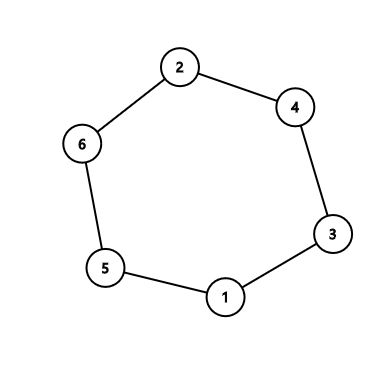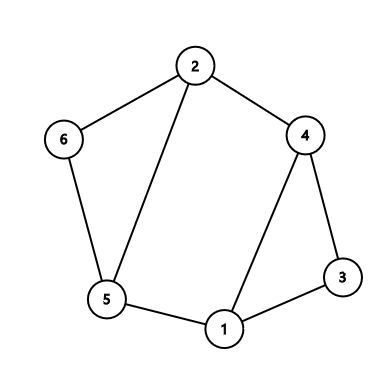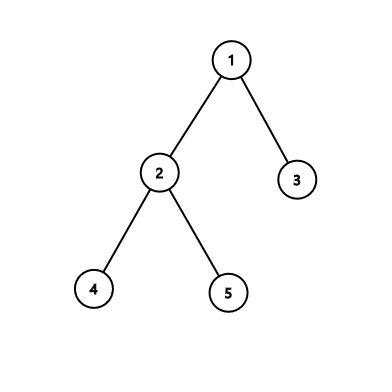Codeforces Round #628 (Div. 2) F. Ehab's Last Theorem(详解)
F. Ehab's Last Theorem
It's the year 5555. You have a graph, and you want to find a long cycle and a huge independent set, just because you can. But for now, let's just stick with finding either.
Given a connected graph with nn vertices, you can choose to either:
- find an independent set that has exactly ⌈n−−√⌉⌈n⌉ vertices.
- find a simple cycle of length at least ⌈n−−√⌉⌈n⌉.
An independent set is a set of vertices such that no two of them are connected by an edge. A simple cycle is a cycle that doesn't contain any vertex twice. I have a proof you can always solve one of these problems, but it's too long to fit this margin.
Input
The first line contains two integers nn and mm (5≤n≤1055≤n≤105, n−1≤m≤2⋅105n−1≤m≤2⋅105) — the number of vertices and edges in the graph.
Each of the next mm lines contains two space-separated integers uu and vv (1≤u,v≤n1≤u,v≤n) that mean there's an edge between vertices uuand vv. It's guaranteed that the graph is connected and doesn't contain any self-loops or multiple edges.
Output
If you choose to solve the first problem, then on the first line print "1", followed by a line containing ⌈n−−√⌉⌈n⌉ distinct integers not exceeding nn, the vertices in the desired independent set.
If you, however, choose to solve the second problem, then on the first line print "2", followed by a line containing one integer, cc, representing the length of the found cycle, followed by a line containing cc distinct integers integers not exceeding nn, the vertices in the desired cycle, in the order they appear in the cycle.
Examples
input
Copy
6 6 1 3 3 4 4 2 2 6 5 6 5 1output
Copy
1 1 6 4input
Copy
6 8 1 3 3 4 4 2 2 6 5 6 5 1 1 4 2 5output
Copy
2 4 1 5 2 4input
Copy
5 4 1 2 1 3 2 4 2 5output
Copy
1 3 4 5Note
In the first sample:
转存失败重新上传取消
正在上传…重新上传取消
转存失败重新上传取消
Notice that you can solve either problem, so printing the cycle 2−4−3−1−5−62−4−3−1−5−6 is also acceptable.
In the second sample:
转存失败重新上传取消
正在上传…重新上传取消
转存失败重新上传取消
Notice that if there are multiple answers you can print any, so printing the cycle 2−5−62−5−6, for example, is acceptable.
In the third sample:
题解:
/**
* pre【】满足sqrt(n)的路径,num【】记录涂0-(sqrt(n)-1)种颜色的点的数量,dep【】记录DFS时的深度,而涂什么颜色也是根据dep%(sqrt(N)-1)来涂的
* 关于为什么取sqrt(N)-1种颜色,如果取2种颜色,而sqrt(n)=4,存在某个环A-B-C-A,按2种颜色存的话就是0-1-0,而这时A和C颜色一样
* 那么此时输出的独立集可能会WA掉,因为A和C并不相互独立,而如果取大于sqrt(n)种颜色,而给的图是一条链,A-B-C-D,涂色的话就是0-1-2-3或者0-1-2-0
* 那么,此时也可能会WA掉,因为你不能保证你每次选择输出的颜色个数都正好存在某种颜色X刚好有sqrt(n)个,所以为了避免这样结果就取sqrt(N)种颜色
* 如果是一条直线,那么也一定存在sqrt(n)个点涂某一种颜色
* DFS的时候,任意选择一个点x,假设x是根节点,其余节点都是x的后代,按深度遍历的时候,
* 如果遍历的是环(假如环是A-B-C-D-E-A),A的深度为5,那么其余分别对应的数字为B-6,C-7,D-8,E-9,遍历到A的时候,形成环,那么
* 就判断这个环的长度是否等于sqrt(n),如果是,就进行输出,输出的时候,pre【】记录的就是路径形成sqrt(n)环的路径,所以只需要反向遍历就可以将环输出
* 如果不等于sqrt(n)的话,A-5,B-6,C-7,D-8,E-9,的深度不变,涂的颜色也不会变,某种颜色的数量也不会改变
* 关于可能存在相邻两个点涂的颜色相同,那么考虑,DFS某一直链时,是否存在两个相邻的数%mod相等呢?很明显,不存在,除非n=1,而n>=5,所以不可能存在
* 那么最后一定存在颜色x,即num【x】>=sqrt(n),而x是由深度%(sqrt(n)-1)得出的,所以,枚举n个点的深度,如果%(sqrt(n)-1)==x,那么输出
*/
/// #include
#include
#include
#include
#include
#include
#include


